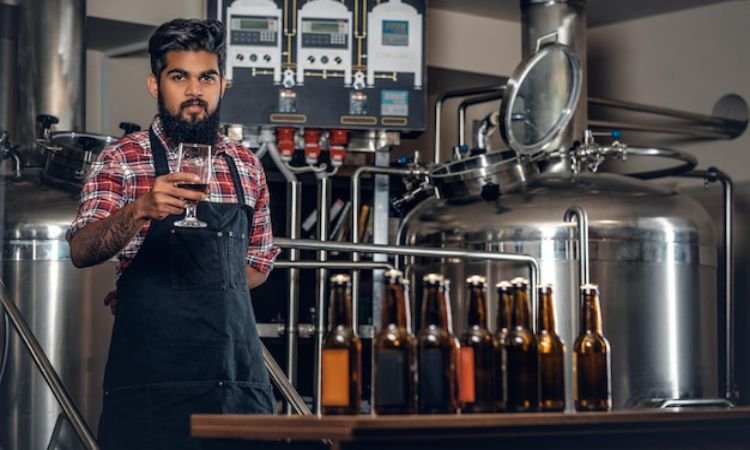 Introduction
Introduction
Brewing beer is an ancient craft that has been around for centuries and it is still a popular activity today. Microbreweries have become increasingly popular as they provide an alternative to mass-produced beer, allowing people to enjoy a variety of flavours and styles of beer. A microbrewery is a small brewery usually producing less than 15,000 barrels of beer per year.
This type of brewery concentrates on producing small batches of unique beers that emphasize flavour, texture and aroma rather than large volumes of generic lagers or ales. Microbrewery in Singapore often uses traditional brewing techniques that have been around for hundreds of years such as open fermentation vessels, wooden barrels or bottle conditioning. With this approach to brewing comes the ability to experiment with different ingredients, flavours and styles creating unique beers for consumers who are looking for something new and interesting.
History of Microbreweries
The history of microbreweries is a tale of incredible innovation and creativity. Microbreweries have been around for centuries, but they have become increasingly popular in the last few decades.
The concept of microbrewing started in the late 19th century with the rise of craft brewing. This was when small breweries began experimenting with different beer styles and recipes, creating unique flavours that had never been seen before. The popularity of these beers eventually led to the development of what we now call microbreweries – small-scale breweries that produce limited amounts of beer for local consumption only.
As microbreweries became more popular, so did their products. By the 1980s and 1990s, craft beers had become widely available throughout the United States, bringing with them an array of unique flavour combinations and creative brewing techniques that were previously unseen on a large scale. This newfound availability allowed consumers to explore new types of beer they may not have tried before and also allowed brewers to experiment with new recipes without having to worry about mass production costs or distribution networks.
 Today’s modern microbrewery industry has grown exponentially over the past few decades as more people are drawn to its variety and quality offerings compared to mass-produced lagers.
Today’s modern microbrewery industry has grown exponentially over the past few decades as more people are drawn to its variety and quality offerings compared to mass-produced lagers.
Benefits of Drinking Microbrews
If you’re a beer lover, you know that there are many different types of beer to choose from. While mass-produced suds are widely available, microbrews have become increasingly popular in recent years. Not only do microbrews offer unique flavours and aromas that you won’t find in your typical lager or ale, but they also come with many benefits. Here are some of the reasons why it may be worth trying out a few microbrews:
1. More Variety
Microbreweries offer an array of beers with unique flavour profiles and ingredients. From fruity IPAs to rich stouts, there is something for everyone when it comes to craft beer. And as more people begin exploring different styles of brews, breweries continue to push the boundaries of innovation by creating new recipes and experimenting with unusual ingredients.
2. Support Local Businesses
Buying local products helps support your community’s economy and creates jobs for people living in the area where the brewery is located. Plus, supporting local businesses means that more money is staying within your community instead of going toward large corporations or out-of-state companies that don’t have any stake in your area’s future development or sustainability efforts.
Types of Microbrews
Microbrews have become increasingly popular in recent years, and it’s easy to see why. Offering a wide variety of flavours and styles, they provide craft beer fans with the opportunity to sample something new every time they raise a glass. But what types of microbrews are available? Here’s an overview of some of the most popular types.
-
Lagers:
Lagers are one of the most common types of microbrews you’ll find on store shelves or at your local brewery. Generally light-bodied and smooth, lagers have subtle malt and hop flavours that make them easy to drink for just about any beer lover. Popular examples include Pilsner, Marzen, Helles, Dunkelweizen, Bock and Vienna Lager.
-
Ales:
Ales tend to be more full-bodied than lagers with distinctive malt or hop flavours that can range from sweet and fruity to bitter or even spicy. Pale ales are generally the most popular type you’ll find in stores or at breweries — think India Pale Ale (IPA), American Pale Ale (APA) and Belgian Pale Ale (BPA). Other common ales include Brown Ales, Stouts & Porters, and Hefeweizens.
Craft Beer Movement and its Impact on the Industry
The craft beer movement has been gaining steam in recent years, and it has had a major impact on the beer industry as a whole. Craft beers are often more flavorful and higher in alcohol content than their mainstream counterparts, which can be quite appealing to many consumers. This trend has seen an explosion of new breweries popping up all over the country, with each one offering unique takes on traditional beer styles.
The craft beer movement is rooted in the idea that traditional brewing practices should be respected and celebrated. Brewers strive to use high-quality ingredients and create unique flavours while still adhering to traditional brewing techniques. Craft breweries offer a wide variety of beers that range from light lagers to rich stouts, making them appealing to many different types of consumers. The rise in popularity of craft beers has sparked an interest among brewers who are looking for ways to stand out from their competition by creating something truly special for their customers.
The popularity of craft beers has also had an effect on the larger industry as well. Bigger companies have taken notice and started producing “craft-style” beers that mimic some of the more popular flavours being produced by smaller brewers without sacrificing quality or taste.
Popular Microbrewery Locations in the U.S
In recent years, the craft beer industry has experienced an unprecedented surge in popularity. From fruity IPAs to rich stouts, many enthusiasts are turning away from mass-produced lagers and seeking out microbreweries for their unique flavours and local appeal. With thousands of microbreweries across the U.S., there’s no shortage of great places to sample some of the best brews around. Here are some popular microbrewery locations in the U.S.
Portland, Oregon: Home to over 70 breweries within city limits, Portland is often referred to as “Beervana” for its thriving craft beer culture and abundance of quality brews. Many of these establishments offer traditional styles like pilsners and pale ales alongside more experimental offerings such as barrel-aged sours and imperial stouts. Some favourites include Cascade Brewing Barrel House, Hair Of The Dog Brewery & Tasting Room, Deschutes Brewery Portland Public House, Base Camp Brewing Company and Hopworks Urban Brewery – all offering delicious beers with a unique Pacific Northwest flair.
San Diego County, California: San Diego is one of America’s most beloved cities when it comes to craft beer – boasting over 150 breweries throughout its county lines.
Regulations and Challenges Faced by Microbreweries
Microbreweries are on the rise in many communities around the world. These small-scale breweries provide a unique way for craft beer lovers to enjoy their favourite suds. But, while these breweries may seem like an easy business venture, they face numerous regulations and challenges as they strive to bring their product to market and remain profitable.
The first challenge microbreweries have is obtaining a license from local, state and federal governments. Depending on the region, this can be an arduous process that requires extensive paperwork and fees. Additionally, most states have strict regulations about the labelling and advertising of beer products which must be adhered to or risk hefty fines or other penalties for violations.
Another major challenge for microbreweries is taxes. Alcoholic beverages are subject to excise taxes at both the state and federal levels in order to offset costs associated with public safety services such as police officers or emergency medical technicians who may respond when people drink alcohol in excess and become ill or injured. As a result, it can be difficult for brewers to remain profitable while still paying these taxes on top of production costs like ingredients, labour and packaging supplies.
Conclusion
In conclusion, microbreweries have a unique approach to producing beer which allows them to create more flavorful and interesting varieties than their larger counterparts. Their small size also allows them to be more responsive to customer demand and create exclusive products that can’t be found anywhere else. With an ever-growing market for craft beer, microbreweries offer consumers a wide variety of choices and an enjoyable experience that will keep them coming back for more.




